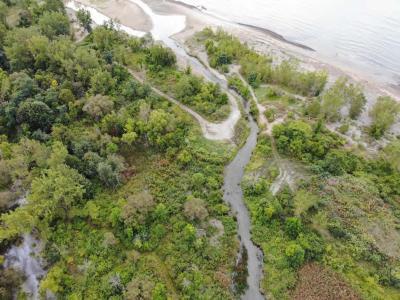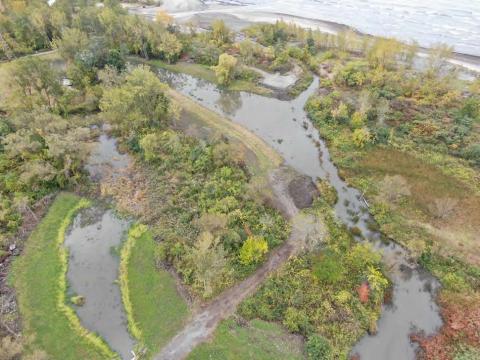New York State Office of Parks, Recreation and Historic Preservation (OPRHP) is making strides to enhance biodiversity, wildlife habitat and improve water quality at Woodlawn Beach State Park through a grant from the Great Lakes Restoration Initiative (GLRI). OPRHP completed a project in 2023 focused on the expansion and enhancement of coastal wetland habitat along Lake Erie that is intended to benefit wildlife and improve water quality by increasing water circulation between the wetland and Blasdell Creek. The project involved expanding an existing wetland, installing a culvert [a structure which allows water to pass under a road or another barrier] to connect the wetland and adjacent Blasdell Creek, removing and controlling invasive species, and planting native wetland vegetation.
The area of Woodlawn Beach State Park is heavily urbanized and water quality in the park is often poor, particularly from elevated bacteria levels. With the project complete, water in Blasdell Creek will now flow through the expanded 4-acre oxbow-shaped wetland. The final elevations and contours in the wetland were designed to support native wetland plants and to allow physical and biological processes to remove pollutants from the water before re-entering to Blasdell Creek and into Lake Erie. The expanded wetland habitat, invasive species control, and extensive planting of native trees, shrubs and aquatic plants will also benefit wildlife such as birds, fish, reptiles, and amphibians.
Coastal wetlands are valuable resources to protect and restore due to the ecosystem services they provide. Some of which include providing habitat for critical species, protection against floods, water purification, and recreational opportunities which all occur at Woodlawn Beach State Park. The coastal wetland in the park will be positively impacted from this project by improving water quality in the park and the Lake Erie shoreline, increasing, and improving wildlife habitat, and conserving biodiversity such as the rare Wafer Ash tree that occurs in the park and prefers wetland habitats. This project will also benefit the many visitors to the park that come to walk, swim, birdwatch and enjoy a natural area on the shores of Lake Erie.



